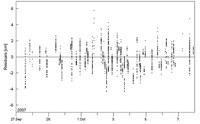TerraSAR-X Precise Orbit Determination
Mission and Spacecraft

TerraSAR-X is an advanced SAR-satellite system for scientific and commercial applications, which is realized in a public-private partnership between DLR and Astrium GmbH. The satellite has a size of 5 m x 2.4 m, a mass of 1200 kg and carries a high-resolution syn-thetic aperture (SAR) radar operating in the X-band (9.65 GHz). TerraSAR-X was launched by a Russian DNEPR-1 rocket from Baikonour, Kazakhstan, on June 15, 2007, 2:14 UTC. TerraSAR-X orbits the Earth in a 514 km Sun-synchronous dusk-dawn orbit with a 97° inclination and an 11 day repeat period. For the performance of high quality repeat pass SAR interferometry, the motion of TerraSAR-X is controlled in a predefined tube of 250 m radius troughout the entire mission. TerraSAR-X is planned to be operated for a period of 5 years and will therefore provide SAR data on a long-term, operational basis. TerraSAR-X Mission operations are performed by DLR's German Space Operations Center (GSOC) at Oberpfaffenhofen. Data dumps and uploads of new commands are performed once every 12 hours via the Weilheim and Neustrelitz groundstations.

The TerraSAR-X spacecraft carries a total of three GPS receivers for navigation and scientific investigations. A redundant pair of MosaicGNSS single frequency-GPS receivers provides onboard navigation and timing information with a representative accuracy of 10 m and is furthermore used for coarse ground based orbit determination. In addition TerraSAR-X carries an IGOR dual-frequency GPS receiver for precise orbit determination and atmospheric sounding, which has been contributed by the GeoForschungsZentrum (GFZ), Potsdam. Prior to the mission, both receivers have been validated in extensive ground tests. As part of these tests, the tracking and navigation performance has been characterized in a signal simulator test bed.
Orbit Determination Requirements
The mission and science operations of TerraSAR-X requires different levels of orbit products which are summarized in the following table.
Product | Description | Performance (3D rms) | Delivery |
|---|---|---|---|
Type 0 | Predicted orbit (for mission planning) | 100 m | 2 hours after end of pass |
Type 1 | Quick-look orbit (for initial product validation) | 10 m | 2 hours after end of pass |
Type 2 | Rapid orbit (for SAR image generation) | 2 m | 24 hours after end of pass |
Type 3 | Science orbit (for SAR interferometry) | 10 cm | 30 days |
Delivery of the science orbit is subject to availability of measurements from the IGOR receiver. Using only MosaicGNSS measurements, an orbit determination of accuracy of at best 1 m can be achieved.
Precise Orbit Determination

The routine generation of Type 2 and 3 orbits for TerraSAR at DLR/GSOC is performed with the GHOST tools suite. Following the preprocessing (data extraction, clock offset correction, RINEX conversion, sorting and merging) of the raw MosaicGNSS and IGOR measurements, the precise orbit determination is performed in a three step process involving single-point positioning, smoothing and reduced dynamic orbit adjustment. Data from the two receivers are processed in a similar manner, but using different data types and combinations. While a traditional ionosphere-free carrier-phase combination with anoise of about 3 mm can be formed from the IGOR dual-frequency measurements, a GRAPHIC (GRoup and PHase Ionosphere Correction) code-carrier combination is formed in case of the single-frequency MosaicGNSS receiver. It is liklewise free of ionospheric path delays but exhibits a much high noise level of about 2 m.
Satellite laser ranging measurements from high grade stations such as Herstmonceaux, Graz, Greenbelt, Mount Stromlo, Yarragadee, and Zimmerwald match the IGOR-based precise orbit determination results with an rms error of down to 1.5 cm. This indicates an overall Type 3 POD accuracy of 5 cm rms and matches the performance previously achieved for the GRACE satellites.
Further Reading
D’Amico S., Arbinger Ch., Kirschner M., Campagnola S.;
Generation of an Optimum Target Trajectory for the TerraSAR-X Repeat Observation Satellite;
18th International Symposium on Space Flight Dynamics, 11-15 Oct. 2004, Munich, Germany (2004).
Arbinger Ch., D’Amico S., Eineder M.;
Precise Ground-In-the-Loop Orbit Control for Low Earth Observation Satellites;
18th International Symposium on Space Flight Dynamics, 11-15 Oct. 2004, Munich, Germany (2004).
Montenbruck O., Williams J., Wang T., Lightsey G.;
Preflight Validation of the IGOR GPS Receiver for TerraSAR-X;
DLR-GSOC GTN-TST-0200; Deutsches Zentrum für Luft- und Raumfahrt, Oberpfaffenhofen (2005).
Montenbruck O.;
Preflight Validation of the MosaicGNSS GPS Receiver for TerraSAR-X;
DLR-GSOC GTN-TST-0210; Deutsches Zentrum für Luft- und Raumfahrt, Oberpfaffenhofen (2005).
Montenbruck O., van Helleputte T., Kroes R., Gill E.;
Reduced Dynamic Orbit Determination using GPS Code and Carrier Measurements;
Aerospace Science and Technology 9/3, 261-271 (2005).
DOI 10.1016/j.ast.2005.01.003
Montenbruck O., Garcia-Fernandez M., Williams J.;
Performance Comparison of Semi-Codeless GPS Receivers for LEO Satellites;
GPS Solutions 10, 249-261 (2006).
DOI 10.1007/s10291-006-0025-9
Montenbruck O., Yoon Y.;
Inflight Performance Validation of the TerraSAR-X GPS Receivers;
DLR-GSOC TN 07-01; Deutsches Zentrum für Luft- und Raumfahrt, Oberpfaffenhofen (2007).
